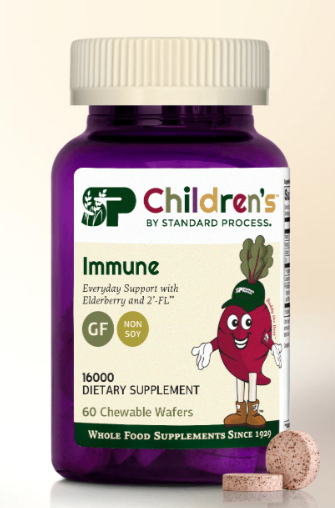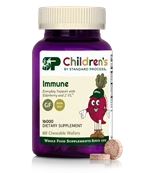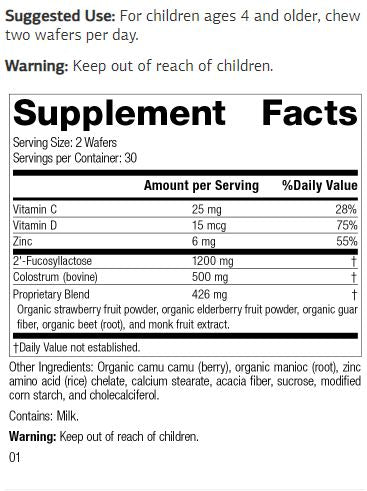Standard Process
SP Children’s™ Immune
Couldn't load pickup availability
SP Children’s™ Immune is a chewable supplement for kids ages 4 and older that delivers key nutrients for proper immune system functioning and development.*
- Supports the immune system*
- Contains prebiotic 2’-FL and bovine colostrum
- Made from whole food-based ingredients
- Draws flavor from organic ingredients: elderberry and whole strawberry
- Is an excellent source of vitamin D, zinc, and antioxidant vitamin C
Vitamin C, Vitamin D, and Zinc: Where Immune Systems Get Their Strength
Vitamin C, vitamin D, and zinc are vitally important for the immune system throughout all life stages, including childhood.1 SP Children’s™ Immune is an excellent source of all three.- Children need Vitamin C for a functioning immune system2
- Vitamin D is a regulator of immune function1
- Zinc is an essential mineral for immune system function3
Contains Prebiotic 2’-FL and Colostrum
The largest immune organ in the body is the GI tract. That’s why SP Children’s™ Immune contains important ingredients that may support the gut and may contribute to a healthy immune system response*:- 2’-FL, a prebiotic first identified in human milk, is able to reach the lower GI tract4-9 where it is broken down to feed the growth of beneficial microbes6-11*^
- Bovine colostrum is sourced from a whole food (cow’s milk) and supports a normal healthy immune response in the GI tract12
Made Safe and Effective for Children
In a taste and tolerance study, SP Children's™ Immune was considered safe and well-tolerated by children between 4 to 17 years old. No indications of adverse effects were observed.Like all Standard Process products, SP Children's™ Immune is subject to a rigorous quality control program. Our scientists run as many as 2,000 tests every week on raw materials, in-process product batches, and finished products so that we can be sure what is in the bottle reflects what is on the label.
Frequently Asked Questions
The average, properly trained adult immune system has fully developed tolerance. Because children have naive adaptive immune systems, they tend to rely more on their innate system (which is often fully functional by two years of age) than an average adult.
Following initial innate responses, the fragments left from an environmental challenge are then presented to the adaptive immune system cells to ultimately develop long-lasting memory. Ensuring the proper concentration of macro- and micronutrients is critical for a child’s health and prepares the child’s immune system for future encounters.
Visit WholisticMatters.com for more information.
1. Calder PC. Proc Nutr Soc. 2013 Aug;72(3):299-309. doi: 10.1017/ S0029665113001286.
2. Maggini S, Wenzlaff S, Hornig D. Journal of International Medical Research. 2010;38(2):386-414. doi: 10.1177/147323001003800203.
3. Shankar AH, Prasad AS. The American journal of clinical nutrition. 1998;68(2 Suppl):447s-63s. Epub 1998/08/13. doi: 10.1093/ajcn/68.2.447S. PubMed PMID: 9701160.
4. Milani C, Duranti S, Bottacini F, Casey E, Turroni F, Mahony J, et al. MMBR. 2017;81(4):e00036-17. doi: 10.1128/MMBR.00036-17.
5. Underwood MA, Gaerlan S, De Leoz MLA, Dimapasoc L, Kalanetra KM, Lemay DG, et al. 2015;78(6):670.
6. Elison E, Vigsnaes LK, Rindom Krogsgaard L, Rasmussen J, Sorensen N, McConnell B, et al. 2016;116(8):1356-68. Epub 2016/10/22. doi: 10.1017/ S0007114516003354.
7. Iribarren C, Törnblom H, Aziz I, Magnusson MK, Sundin J, Vigsnæs LK, et al. 2019;156(6):S-242. doi: 10.1016/S0016-5085(19)37409-8.
8. Bai Y, Tao J, Zhou J, Fan Q, Liu M, Hu Y, et al. 2018;3(6):e00206-18. doi: 10.1128/ mSystems.00206-18.
9. Sela DA, Mills DA. 2010;18(7):298-307. Epub 04/19. doi: 10.1016/j. tim.2010.03.008.
10. Matsuki T, Yahagi K, Mori H, Matsumoto H, Hara T, Tajima S, et al. 2016;7:11939-. doi: 10.1038/ncomms11939.
11. Asakuma S, Hatakeyama E, Urashima T, Yoshida E, Katayama T, Yamamoto K, et al. J Biol Chem. 2011;286(40):34583-92. Epub 08/09. doi: 10.1074/jbc. M111.248138.
12. Lefranc M-P, Lefranc G. 2001. Academic Press; 2001.






